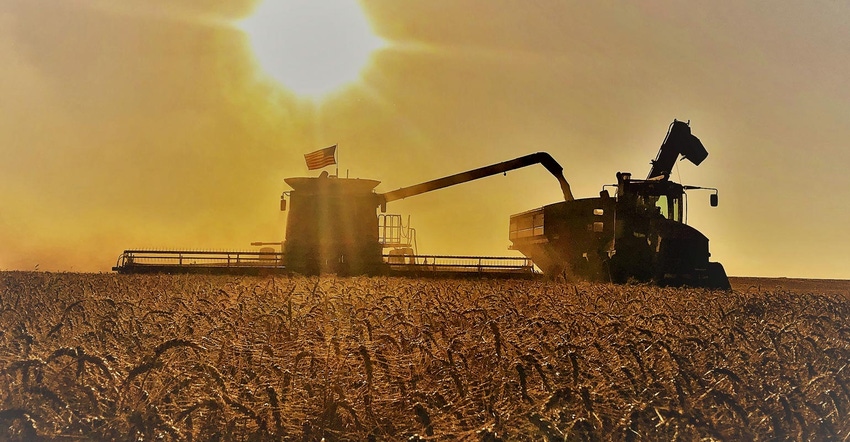October 22, 2020

Over the years, North Dakota farmer Jon Wert grows spring wheat that tops 100 bushels per acre. And 2020 was no different.
“We will see how this year’s 105-bushel entry places,” he says following the 2020 harvest.
In the last four years, the New England farmer is among the top growers in the National Wheat Yield Contest, sponsored by the National Wheat Foundation. Wert has had three entries push past the 100-bushel mark with a Limagrain Trigger variety. His 2019 state win and third-place national placing averaged 101.25 bushels per acre in the dryland category.
A fifth-generation farmer, Wert farms with his wife Sheri, daughter Brenna and son Devin. He says achieving high wheat yields requires good management, offering these tips:
Start with fertility. This year’s 105-bushel wheat was achieved with no more than 105 pounds of actual nitrogen applied as the nitrogen source, with another 10 pounds of nitrogen in the starter fertilizer, Wert says.
“This is closer to one pound of nitrogen per bushel versus the 2 to 2.5 pounds nitrogen per bushel the university suggests is required,” he says.
He credits “fertilizer use efficiency and balance,” for high yields with less input.
“By banding all of our fertilizer at planting time, we are not only saving moisture, but also allowing the plant to most efficiently source its food,” he says. A balance of fertilizer is more important than the total supply.
“We know an excess of a nutrient will have no benefit if another nutrient is lacking,” he says. “Your limiting factor is the one nutrient that you’re short of. With a balanced approach, the plant can efficiently utilize the fertilizer, as there is a synergy between the nutrients, allowing for maximum production. I have tried applying additional nitrogen with zero results.”
Tests that matter. To achieve that balanced ratio of nutrients, Wert soil tests and tissue samples his crop.
“I’m a bigger believer in tissue samples,” he says. “The soil tests are a starting point, but the tissue sample tells us where we’re at during the growing season.” Tissue sampling at the jointing stage, then two to three more times over the growing year, allows him to rescue treat acres.
“A big part of our focus the last couple years has been on fixing low pH soils that we have out here,” Wert says. “God blessed us with good soils here, but we’ve discovered this pH issue.” To resolve this, the farm is applying lime at a rate of 3 tons to the acre on a wet basis.
Build soil health. Another secret to raising high-yielding wheat is the soil’s organic matter.
All of Wert’s high yields have come from fields that have been in no-till since the early 1980s. In those areas, the organic matter is as high as 5%.
“This allows extra nutrients to be released, better moisture retention and fertilizer-holding capacity,” he says.
 FARMING FOR GENERATIONS: Jon and Sheri Wert, along with their daughter Brenna and son Devin, farm in western North Dakota. The family is the fifth generation to farm. By caring for the soil and managing inputs they continue to push the upper limits of wheat yields, something they hope is sustainable for generations to come.
FARMING FOR GENERATIONS: Jon and Sheri Wert, along with their daughter Brenna and son Devin, farm in western North Dakota. The family is the fifth generation to farm. By caring for the soil and managing inputs they continue to push the upper limits of wheat yields, something they hope is sustainable for generations to come.

The Wert farm uses the latest in farming technology, using satellite imagery, yield map analysis and site-specific soil remediation.
Wheat is planted at a rate of 1.5 million seeds per acre, but he admits experimenting until finding the right population for the farm. Part of that is based on drill spacing. Wert notes that differences in equipment dictates plant population.
Ultimately, Wert believes the biggest factor influencing yield is soil health.
“We tend to focus on what we see above ground,” he says, “but this is just a result of what is happening below ground – the stomach of the plant. I love to pull plants and study the roots.”
Do on-farm trials. Wert continually experiments with new products, planting trial strips each year and seeing what impact it has on plant root development.
“Many times, I will see better root development or better vegetation, but no difference in yield,” he says. “Sometimes we will see positive results one year and not the next, so we keep moving forward looking for products or methods we can do for a positive return on investment.”
He admits that 95% of the things he experiments with do not make it across his wheat acres because “they just don’t pencil out.” However, one discovery through his trials has been the benefits of a plant growth promoting rhizobacteria (PGPR) and humic acid, which he has found to be beneficial.
“I try to push my yields for the contest, and then what we gain off of the contest acres we apply to our whole farm if it has a positive return on investment,” Wert says. “But in reality, I’m trying to push my yields on the whole farm all the time, and I’m really not treating my contest acres any different.”
Dart writes from Elgin, N.D.
About the Author(s)
You May Also Like




